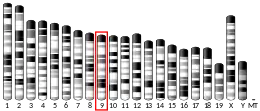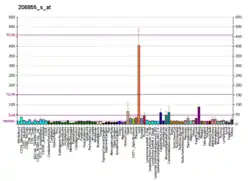Hyaluronidase-2 is a multifunctional protein, previously thought to only possess acid-active hyaluronan-degrading enzymatic function. In humans it is encoded by the HYAL2 gene.[5][6][7]
This gene encodes a protein which is similar in structure to hyaluronidases. Hyaluronidases intracellularly degrade hyaluronan, one of the major glycosaminoglycans of the extracellular matrix. Hyaluronan is thought to be involved in cell proliferation, migration and differentiation.
Varying functions have been described for this protein. It has been described as a lysosomal hyaluronidase which is active at a pH below 4 and specifically hydrolyzes high molecular weight hyaluronan. It has also been described as a GPI-anchored cell surface protein which does not display hyaluronidase activity but does serve as a receptor for the oncogenic virus Jaagsiekte sheep retrovirus. The gene is one of several related genes in a region of chromosome 3p21.3 associated with tumor suppression. This gene encodes two alternatively spliced transcript variants which differ only in the 5' UTR.[7]
One study found associations between cleft lip and palate and mutations in the HYAL2 gene.[8]
An investigation published in 2017, attributed an additional function to the Hyaluronidase 2 (HYAL2) protein. The study found interactions between HYAL2 and proteins involved in the alternative splicing of CD44 pre-mRNA.[9] Another study published in 2020, described roles for HYAL2 in the orchestration of cytoskeletal components involved in myofibroblast contraction.[10] These recent discoveries suggest a broader regulatory role for the HYAL2 protein in cell biology.
References
- 1 2 3 GRCh38: Ensembl release 89: ENSG00000068001 - Ensembl, May 2017
- 1 2 3 GRCm38: Ensembl release 89: ENSMUSG00000010047 - Ensembl, May 2017
- ↑ "Human PubMed Reference:". National Center for Biotechnology Information, U.S. National Library of Medicine.
- ↑ "Mouse PubMed Reference:". National Center for Biotechnology Information, U.S. National Library of Medicine.
- ↑ Lepperdinger G, Strobl B, Kreil G (August 1998). "HYAL2, a human gene expressed in many cells, encodes a lysosomal hyaluronidase with a novel type of specificity". The Journal of Biological Chemistry. 273 (35): 22466–70. doi:10.1074/jbc.273.35.22466. PMID 9712871. S2CID 44868532.
- ↑ Strobl B, Wechselberger C, Beier DR, Lepperdinger G (October 1998). "Structural organization and chromosomal localization of Hyal2, a gene encoding a lysosomal hyaluronidase". Genomics. 53 (2): 214–9. doi:10.1006/geno.1998.5472. PMID 9790770.
- 1 2 "Entrez Gene: HYAL2 hyaluronoglucosaminidase 2".
- ↑ Sandoiu A (2017-01-17). "Scientists find genetic mutation that causes cleft lip and palate, heart defects". Medical News Today. Retrieved 2017-01-31.
- ↑ Midgley AC, Oltean S, Hascall V, Woods EL, Steadman R, Phillips AO, Meran S (November 2017). "Nuclear hyaluronidase 2 drives alternative splicing of CD44 pre-mRNA to determine profibrotic or antifibrotic cell phenotype". Science Signaling. 10 (506): eaao1822. doi:10.1126/scisignal.aao1822. hdl:10871/36504. PMID 29162741. S2CID 12486942.
- ↑ Midgley AC, Woods EL, Jenkins RH, Brown C, Khalid U, Chavez R, et al. (June 2020). "Hyaluronidase-2 Regulates RhoA Signaling, Myofibroblast Contractility, and Other Key Profibrotic Myofibroblast Functions". The American Journal of Pathology. 190 (6): 1236–1255. doi:10.1016/j.ajpath.2020.02.012. PMC 7254050. PMID 32201263.
Further reading
- Lepperdinger G, Müllegger J, Kreil G (December 2001). "Hyal2--less active, but more versatile?". Matrix Biology. 20 (8): 509–14. doi:10.1016/S0945-053X(01)00170-6. PMID 11731268.
- Maruyama K, Sugano S (January 1994). "Oligo-capping: a simple method to replace the cap structure of eukaryotic mRNAs with oligoribonucleotides". Gene. 138 (1–2): 171–4. doi:10.1016/0378-1119(94)90802-8. PMID 8125298.
- Wei MH, Latif F, Bader S, Kashuba V, Chen JY, Duh FM, et al. (April 1996). "Construction of a 600-kilobase cosmid clone contig and generation of a transcriptional map surrounding the lung cancer tumor suppressor gene (TSG) locus on human chromosome 3p21.3: progress toward the isolation of a lung cancer TSG". Cancer Research. 56 (7): 1487–92. PMID 8603390.
- Andersson B, Wentland MA, Ricafrente JY, Liu W, Gibbs RA (April 1996). "A "double adaptor" method for improved shotgun library construction". Analytical Biochemistry. 236 (1): 107–13. doi:10.1006/abio.1996.0138. PMID 8619474.
- Yu W, Andersson B, Worley KC, Muzny DM, Ding Y, Liu W, et al. (April 1997). "Large-scale concatenation cDNA sequencing". Genome Research. 7 (4): 353–8. doi:10.1101/gr.7.4.353. PMC 139146. PMID 9110174.
- Suzuki Y, Yoshitomo-Nakagawa K, Maruyama K, Suyama A, Sugano S (October 1997). "Construction and characterization of a full length-enriched and a 5'-end-enriched cDNA library". Gene. 200 (1–2): 149–56. doi:10.1016/S0378-1119(97)00411-3. PMID 9373149.
- Sun L, Feusi E, Sibalic A, Beck-Schimmer B, Wüthrich RP (1999). "Expression profile of hyaluronidase mRNA transcripts in the kidney and in renal cells". Kidney & Blood Pressure Research. 21 (6): 413–8. doi:10.1159/000025893. PMID 9933825. S2CID 40489637.
- Fiszer-Szafarz B, Litynska A, Zou L (September 2000). "Human hyaluronidases: electrophoretic multiple forms in somatic tissues and body fluids. Evidence for conserved hyaluronidase potential N-glycosylation sites in different mammalian species". Journal of Biochemical and Biophysical Methods. 45 (2): 103–16. doi:10.1016/S0165-022X(00)00067-1. PMID 10989127.
- Lerman MI, Minna JD (November 2000). "The 630-kb lung cancer homozygous deletion region on human chromosome 3p21.3: identification and evaluation of the resident candidate tumor suppressor genes. The International Lung Cancer Chromosome 3p21.3 Tumor Suppressor Gene Consortium". Cancer Research. 60 (21): 6116–33. PMID 11085536.
- Rai SK, Duh FM, Vigdorovich V, Danilkovitch-Miagkova A, Lerman MI, Miller AD (April 2001). "Candidate tumor suppressor HYAL2 is a glycosylphosphatidylinositol (GPI)-anchored cell-surface receptor for jaagsiekte sheep retrovirus, the envelope protein of which mediates oncogenic transformation". Proceedings of the National Academy of Sciences of the United States of America. 98 (8): 4443–8. Bibcode:2001PNAS...98.4443R. doi:10.1073/pnas.071572898. PMC 31854. PMID 11296287.
- Delpech B, Laquerriere A, Maingonnat C, Bertrand P, Freger P (2002). "Hyaluronidase is more elevated in human brain metastases than in primary brain tumours". Anticancer Research. 22 (4): 2423–7. PMID 12174938.
- Liu SL, Duh FM, Lerman MI, Miller AD (March 2003). "Role of virus receptor Hyal2 in oncogenic transformation of rodent fibroblasts by sheep betaretrovirus env proteins". Journal of Virology. 77 (5): 2850–8. doi:10.1128/JVI.77.5.2850-2858.2003. PMC 149765. PMID 12584308.
- Danilkovitch-Miagkova A, Duh FM, Kuzmin I, Angeloni D, Liu SL, Miller AD, Lerman MI (April 2003). "Hyaluronidase 2 negatively regulates RON receptor tyrosine kinase and mediates transformation of epithelial cells by jaagsiekte sheep retrovirus". Proceedings of the National Academy of Sciences of the United States of America. 100 (8): 4580–5. Bibcode:2003PNAS..100.4580D. doi:10.1073/pnas.0837136100. hdl:11382/303276. PMC 153598. PMID 12676986.
- Junker N, Latini S, Petersen LN, Kristjansen PE (2003). "Expression and regulation patterns of hyaluronidases in small cell lung cancer and glioma lines". Oncology Reports. 10 (3): 609–16. doi:10.3892/or.10.3.609 (inactive 1 August 2023). PMID 12684632.
{{cite journal}}: CS1 maint: DOI inactive as of August 2023 (link)




